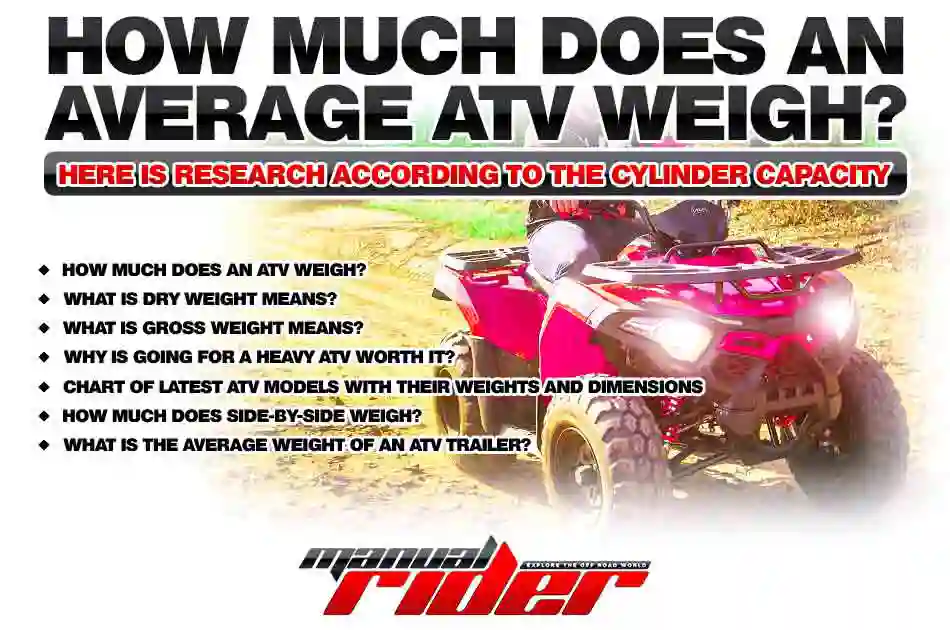
On earth, everything has weight. ATVs are made of metal, iron, and plastic components that give weight. Also, it will carry a rider and fuel, and sometimes we haul a mini SUV and trailer to it. Is your ATV capable of moving with this all? You want to check how much weight is going to ride with you. When you get the ATV, you want to ride it on the corners, rocks, mud, or sand. In some cases, ATVs can be stuck or rolled over.
If you buy a 1000-pound ATV, how do you manage it? Are you capable of managing that weight in an emergency alone? You know buying an ATV is an investment, and we must make correct decisions before buying. I will guide you in this article on why ATV weight is essential. And I will give you researched average ATV weight chart FREE. Stay tuned and keep reading manual riders!
How much does an ATV weigh?
I created a PDF with all details with the average ATV weight according to engine cylinder capacity. In case, these numbers can change according to the ATV models and upgrades. According to my research, the Average ATV weight is around 215lbs – 840lbs (98kg – 381kg).
What is dry weight means?
Dry weight is ATV weight without any fluid, engine oil, brake oil, or fuel on the vehicle. Also, they call it “curb weight.”
What is gross weight means?
Gross weight refers to how much load can pull by the ATV.
Why is Buying a heavy ATV worth it?
Pros
- Heavy ATVs can perform more heavy duties and can finish the job efficiently.
- Heavy ATVs come with better suspension and feel comfortable in rough environments.
- Heavy ATVs are safer than a lighter ones because light ATVs can roll over easily.
- You can ride a fast safer than a light ATV because heavy ATVs have the best performance.
Cons
- Heavy ATVs need more fuel to run.
- Mostly, if ATVs get heavier, its price will go up.
Chart of Latest ATV models with their Weights and dimensions
| Manufacturer | Name | Wet weight | Wet weight | Fuel capacity | Dimensions |
| Yamaha Sport | 2023 YFZ 50 | 220lbs | 99.8kg | 1.5gal | 49.2 in x 32.3 in x 30.3 in |
| Yamaha Sport | 2023 RAPTOR 90 | 279lbs | 126.6kg | 1.7gal | 58.5 in x 40.2 in x 37.6 in |
| Yamaha Sport | 2023 YFZ450R | 405lbs | 183.7kg | 2.6gal | 70.7 in x 48.8 in x 41.9 in |
| Yamaha Sport | 2023 YFZ450R SE | 405lbs | 183.7kg | 2.6gal | 70.7 in x 48.8 in x 41.9 in |
| Yamaha Sport | 2023 RAPTOR 700 | 422lbs | 191.4kg | 2.9gal | 72.6 in x 45.5 in x 43.9 in |
| Yamaha Sport | 2023 RAPTOR 700R | 422lbs | 191.4kg | 2.9gal | 72.6 in x 45.5 in x 43.9 in |
| Yamaha Sport | 2023 RAPTOR 700R SE | 422lbs | 191.4kg | 2.9gal | 72.6 in x 45.5 in x 43.9 in |
| Yamaha Utility | 2023 GRIZZLY 90 | 308lbs | 139.7kg | 1.7gal | 61.5 in x 40.6 in x 39.6 in |
| Yamaha Utility | 2023 KODIAK 450 EPS | 650lbs | 294.8kg | 3.7gal | 80.1 in x 46.5 in x 45.7 in |
| Yamaha Utility | 2023 Kodiak 450 EPS SE | 680lbs | 308.4kg | 3.7gal | 80.4 in x 46.5 in x 47.0 in |
| Yamaha Utility | 2023 KODIAK 700 EPS | 686lbs | 311kg | 4.8gal | 81.5 in x 46.5 in x 48.8 in |
| Yamaha Utility | 2023 KODIAK 700 EPS SE | 686lbs | 311kg | 4.8gal | 81.5 in x 46.5 in x 48.8 in |
| Yamaha Utility | 2023 GRIZZLY EPS | 701lbs | 317.9kg | 4.8gal | 81.5 in x 48.4 in x 49.3 in |
| Yamaha Utility | 2023 GRIZZLY EPS SE | 754lbs | 342kg | 4.8gal | 81.5 in x 49.2 in x 50.0 in |
| Yamaha Utility | 2023 GRIZZLY EPS XT-R | 783lbs | 355kg | 4.8gal | 81.5 in x 49.2 in x 50.0 in |
| Can-am | 2023 OUTLANDER 450 | 700lbs | 318kg | 5.4gal | 83 x 46 x 49 in |
| Can-am | 2023 OUTLANDER 570 | 720lbs | 327kg | 5.4gal | 83 x 46 x 49 in |
| Can-am | 2023 OUTLANDER XT 570 | 720lbs | 327kg | 5.4gal | 83 x 46 x 49 in |
| Can-am | 2023 OUTLANDER HUNTING EDITION 450 | 700lbs | 318kg | 5.4gal | 83 x 46 x 49 in |
| Can-am | 2023 OUTLANDER HUNTING EDITION 570 | 720lbs | 327kg | 5.4gal | 83 x 46 x 49 in |
| Can-am | 2023 OUTLANDER MR 570 | 830lbs | 376kg | 5.4gal | 83 x 46 x 49 in |
| Can-am | 2023 OUTLANDER X MR 570 | 845lbs | 383kg | 5.4gal | 83 x 46 x 49 in. |
| Can-am | 2023 OUTLANDER MAX 450 | 774lbs | 337kg | 5.4gal | 91 x 46 x 52.5 in |
| Can-am | 2023 OUTLANDER MAX 570 | 764lbs | 347kg | 5.4gal | 91 x 46 x 52.5 in |
| Can-am | 2023 OUTLANDER MAX DPS 450 | 744lbs | 337kg | 5.4gal | 91 x 46 x 52.5 in |
| Can-am | 2023 OUTLANDER MAX DPS 570 | 764lbs | 347kg | 5.4gal | 91 x 46 x 52.5 in |
| Can-am | 2023 OUTLANDER MAX XT 570 | 764lbs | 347kg | 5.4gal | 91 x 46 x 52.5 in |
| Can-am | 2023 OUTLANDER MAX 6X6 DPS 450 | 1000lbs | 454kg | 5.4gal | 118 x 46 x 57 in |
| Can-am | 2023 OUTLANDER | 817lbs | 371kg | 5.4gal | 86 x 48 x 49.5 in |
| Can-am | 2023 OUTLANDER DPS | 817lbs | 371kg | 5.4gal | 86 x 48 x 49.5 in |
| Can-am | 2023 OUTLANDER XT 850 | 817lbs | 371kg | 5.4gal | 86 x 48 x 49.5 in |
| Can-am | 2023 OUTLANDER XT 1000R | 895lbs | 406kg | 5.4gal | 86 x 48 x 49.5 in |
| Can-am | 2023 OUTLANDER HUNTING EDITION 850 | 817lbs | 371kg | 5.4gal | 86 x 48 x 49.5 in |
| Can-am | 2023 OUTLANDER XT-P 850 | 869lbs | 394kg | 5.4gal | 86 x 48 x 49.5 in |
| Can-am | 2023 OUTLANDER XT-P 1000R | 954lbs | 433kg | 5.4gal | 86 x 48 x 49.5 in |
| Can-am | 2023 OUTLANDER X XC | 895lbs | 406kg | 5.4gal | 86 x 48 x 49.5 in |
| Can-am | 2023 OUTLANDER X MR 850 | 951lbs | 431kg | 5.4 gal | 88 x 50 x 51.5 in |
| Can-am | 2023 OUTLANDER X MR 1000R | 1014lbs | 460 | 5.4 gal | 97 x 50 x 51.5 in |
| Can-am | 2023 OUTLANDER MAX DPS | 869lbs | 394kg | 5.4 gal | 94 x 48 x 53 in |
| Can-am | 2023 OUTLANDER MAX XT 850 | 869lbs | 394kg | 5.4 gal | 94 x 48 x 53 in |
| Can-am | 2023 OUTLANDER MAX XT 1000R | 954lbs | 433kg | 5.4 gal | 94 x 48 x 53 in |
| Can-am | 2023 OUTLANDER MAX XT-P 850 | 869lbs | 394kg | 5.4 gal | 94 x 48 x 53 in |
| Can-am | 2023 OUTLANDER MAX XT-P 1000R | 954lbs | 433kg | 5.4 gal | 94 x 48 x 53 in |
| Can-am | 2023 OUTLANDER MAX LIMITED | 954lbs | 433kg | 5.4gal | 94 x 48 x 53 in |
| Can-am | 2023 OUTLANDER MAX 6X6 DPS 650 | 1100lbs | 499kg | 5.4gal | 124.8 x 48.5 x 55.3 in |
| Can-am | 2023 OUTLANDER MAX 6X6 XT 1000 | 1170lbs | 531kg | 5.4gal | 124.8 x 48.5 x 55.3 in |
| Can-am | 2023 RENEGADE 70 EFI | 290lbs | 130kg | 1.6gal | 59 x 38 x 36 in |
| Can-am | 2023 RENEGADE 110 EFI | 295lbs | 134kg | 1.6gal | 60.6 x 40.4 x 38.6 in |
| Can-am | 2023 RENEGADE X XC 110 EFI | 310lbs | 140kg | 1.6gal | 60.6 x 40.4 x 38.6 in |
| Can-am | 2023 RENEGADE | 750lbs | 340kg | 5.4gal | 86 x 48 x 49 in |
| Can-am | 2023 RENEGADE X XC | 795lbs | 361kg | 5.4gal | 86 x 48 x 49 in |
| Can-am | 2023 RENEGADE X MR 650 | 870lbs | 395kg | 5.4gal | 83 x 50 x 56 in |
| Can-am | 2023 RENEGADE X MR 1000R | 971lbs | 440kg | 5.4gal | 83 x 50 x 56 in |
| Can-am | 2023 DS 250 | 429lbs | 195kg | 3.3gal | 72 x 40.5 x 43.5 in |
| Arctic cat | ALTERRA 450 | 613lbs | 278kg | 4.3gal | 83.9 x 44 x 46.9 in |
| Arctic cat | ALTERRA 600 BLACK HILLS EDITION | 905.7lbs | 410.8kg | 5.7gal | 86.5 x 47.8 x 51.1 in |
| Arctic cat | ALTERRA 600 MUD PRO | 891.7lbs | 404.5kg | 5.7gal | 86.5 x 47.8 x 51.1 in |
| Arctic cat | ALTERRA 600 TRV XT | 836.1lbs | 376kg | 5.7gal | 91.1 x 48.8 x 50.1 in |
| Arctic cat | ALTERRA 600 TRV EPS | 836.1lbs | 376kg | 5.7gal | 91.1 x 48.8 x 50.1 in |
| Arctic cat | ALTERRA 300 | 517lbs | 235kg | 3.2gal | 72.6 x 41.3 x 45.8 in |
| Arctic cat | ALTERRA 90 | 283lbs | 128kg | 1.4gal | 59 x 34.5 x 37.9 in |
| Honda | 2023 FOURTRAX RINCON | 658lbs (Curb weight) | 298kg | 4.4 | 83.3 x 46.7 x 47.5 in |
| Honda | 2023 FOURTRAX FOREMAN RUBICON 4X4 | 710lbs (Curb weight) | 322kg | 3.9 | 86 x 47.4 x 48.7 in |
| Honda | 2023 FOURTRAX FOREMAN 4X4 | 648lbs (Curb weight) | 294kg | 3.9 | 82.9 x 47.4 x 47.8 in |
| Honda | 2023 FOURTRAX RECON | 437lbs (Curb weight) | 198kg | 2.4 | 75 x 40.7 x 42.1 in |
| Honda | 2023 FOURTRAX RANCHER | 582lbs (Curb weight) | 264kg | 3.9 | 82.8 x 47.4 x 46.2 in |
| Honda | 2023 TRX250X | 385lbs (Curb weight) | 175kg | 2.5 | 68.5 x 41.8 x 42.6 in |
| Honda | 2023 TRX90X | 262lbs (Curb weight) | 119kg | 1.7 | 58.6 x 35.2 x 36.5 in |
How much does side-by-side weigh?
Side by side or UTVs are always heavier than ATVs. The average wet weight of side-by-side can be around 700-1500 pounds. Two seater UTVs can be around 1000 – 1600 pounds, and four seater side by side can be around 1400-2200 pounds.

What is the Average weight of an ATV trailer?
ATV trailer weight can be around 600 – 2000lbs. This weight range can be changed with the tires and martial used to make it. If you are looking for a tow, its weight can be around 400 – 850lbs, but the maximum weight you can carry by ATV is 3000lbs. it includes the ATV weight too. So, it would be best if you went below 3000lbs with the ATV weight to go on the road.
The Bottom line
I hope you have a pretty good idea about ATV weight and how to select a suitable weight for purchases. Weight is a big concern while you are riding for a race. But weight is more critical when you use ATV for heavy work or going off-road. Make a little checklist and decide the best weight you want for the ATV. Follow the article if you get any problems. I hope every answer is in there. Good luck, manual riders!
Recent Posts
When I first bought my ATV, I imagined riding everywhere on it just like a flash. But some friends told me you couldn't ride it on public roads as you like. That's true! There are big rules to follow...
ATV tires need to be replaced when they wear off while riding over time. Sharpen obstacles on off-road trails always damage tires. So, How long should ATV tires last? Normally, it would be best if...
